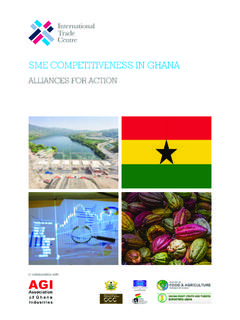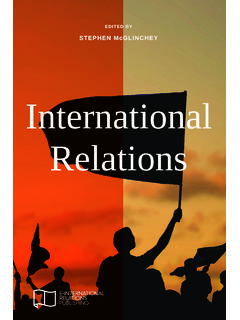Transcription of A Comprehensive Review of the Major Studies and ...
1 Higher Education Studies ; Vol. 6, No. 2; 2016 ISSN 1925-4741 E-ISSN 1925-475X Published by Canadian center of Science and Education 1 A Comprehensive Review of the Major Studies and Theoretical Models of Student Retention in Higher Education Othman Aljohani1 1 English Language Centre, Institute of Public Administration, Jeddah, Saudi Arabia Correspondence: Othman Aljohani, ELC, Institute of Public Administration, P. O. Box 5014, Jeddah, 21141, Saudi Arabia. E-mail: Received: February 4, 2016 Accepted: February 20, 2016 Online Published: February 24, 2016 doi: URL: Abstract Student retention rate has been a Major concern for tertiary institutions around the world since the establishment of formal education.
2 Generally speaking, not every student completes his or her study program. Although students fail to graduate for different reasons, some of them choose to voluntarily withdraw from their study programs. This might affect the image of the tertiary institutions in many different ways including their academic reputation and financial plans. To deal with such critical issue, there is a need for strategies and plans that are based on the findings of scientific research. The literature of student retention in higher education is rich of the theoretical models and empirical Studies that gained consideration among researchers and educators over the last four decades. Therefore, some of these Studies and theoretical models were comprehensively reviewed and discussed.
3 The purpose of this is to provide researchers, educators and policy makers with a background to this issue and the latest strategies and techniques that help them deal with it as well as to find the common patterns and themes of the mostly reported student attrition factors. Keywords: higher education, student retention, attrition, persistence 1. Introduction Student attrition has been one of the most a critical issues in higher education for long time. Low student retention rates might affect tertiary institutions in many different aspects including their academic and financial plans. Thus, it is important to deal with such critical issue through strategies and plans that are based on the findings of scientific research.
4 Moreover, it is essential for the educators and policy makes who seek solutions for such a problem to have an understanding of the background of the student retention phenomenon and the most frequent factors that lead students to leave their study programs. The literature of student retention in higher education is rich of the theoretical models and empirical Studies that gained consideration among researchers and educators over the last four decades. This paper gives a Comprehensive Review of the highly cited and adopted Studies and theoretical models of student retention in higher education. It does so by giving a historical background of student retention Studies and models, trace their development over the past four decades, presents, Review the Major conceptual and theoretical models in the literature of student retention in higher education, and discuss their limitations.
5 2. Historical Background of Student Retention Studies Although the student attrition phenomenon has been a Major concern for educational institutions and educators since the establishment of the formal education system (Habley, Bloom, & Robbins, 2012; Seidman, 2005; Tinto, 1993), theoretical models arising from the systematic study of the phenomenon were not developed until the early 1970s (Berger, Ramirez, & Lyon, 2012). Berger et al. (2012, p. 13) divided the development of student retention Studies chronologically into nine eras, as listed in Table 1. These eras start from the prehistory of student retention, when retention was not considered as an issue because graduating was not the goal of students, and continue to the current era, in which the theoretical and conceptual foundations of the phenomenon have been established and the implications set.
6 Further, Berger et al. (2012) divided these eras into two main categories. In the first category, they grouped all the eras before the 1960s (four eras) together, as they share a lack of a systematic approach towards student retention. The second category includes the last five eras, starting from the 1960s and continuing until the Higher Education Studies Vol. 6, No. 2; 2016 2 present. The authors argued that during this period, student retention become a global concern and consequently systematic and theoretical Studies were developed. Table 1. Eras of the development of student retention Studies Era Period Retention Prehistory 1600s-mid-1800s Evolving towards retention Mid-1800s-1900 Early developments 1900-1950 Dealing with expansion 1950s Preventing dropout 1960s Building theories 1970s Managing enrolment 1980s Broadening horizons 1990s Early twenty-first century Current and future trends 3.
7 Development of Student Retention Theoretical Models Before 1970, various attempts were made to study the student attrition phenomenon (Bayer, 1968; Campbell & Fiske, 1959; Feldman & Newcomb, 1969; Marks, 1967; Marsh, 1966; Panos & Astin, 1968; Summerskill, 1962). However, the focus of these Studies was principally on the characteristics of individual students, rather than on their interactions with college environments. The student attrition phenomenon was often explained in terms of the students characteristics, personal attributes and shortcomings (Berger et al., 2012; Habley et al., 2012; Spady, 1970, 1971; Tinto, 1993, 2006). According to Berger et al. (2012), previous Studies had been grounded in psychology rather than sociology (p.)
8 18). Moreover, as Spady (1970) noted, these Studies lacked theoretical and empirical coherence .. conceptual clarity, methodological rigor, complexity of design, breadth, and analytic sophistication .. definite theoretical basis (p. 64). He concluded his Review of the student retention literature before 1970 with the assertion that the absence of what he called an analytical-explanatory category is unfortunate and glaring (Spady, 1970, p. 64). During the late 1960s and the 1970s, systematic Studies and attempts to conceptualise retention frameworks that included the notion of the student-college relationship became more common (Bayer, 1968; Bean, 1980; Feldman & Newcomb, 1969; Marsh, 1966; Panos & Astin, 1968; Spady, 1970, 1971; Terenzini & Pascarella, 1977; Tinto, 1975).
9 According to Berger et al. (2012), by 1970, the era of building retention theories had begun, largely with William s (1971) work, Dropouts from Higher Education: An Interdisciplinary Review and Synthesis . This was the first sociological student retention model. According to Spady, there are two systems in each college (academic and social) and at least two factors in each system that influence a student s decision to withdraw: grades and intellectual development in the academic system and normative congruence and friendship support in the social system. After Spady s work, later Studies and models took into account the nature of students institutional relationships. By the 1970s, the introduction of the term retention to describe student persistence included the concept that institutions shared responsibility in influencing students decisions regarding dropping out (Habley et al.)
10 , 2012). Since then, many student retention Studies have been conducted and theoretical models have been developed, such as Tinto s Institutional Departure Model (1975, 1993), Bean s Student Attrition Model (1980, 1982), the Student Faculty Informal Contact Model (Pascarella, 1980), Astin s Student Involvement Model (1984), the Non-traditional Student Attrition Model (Bean & Metzner, 1985) and the Student Retention Integrated Model (Cabrera, Nora, & Castaneda, 1993). Some of these theoretical models are reviewed in this paper. Theoretical and Conceptual Roots of Student Retentions Models While the theoretical and conceptual backgrounds of the student retention models are varied, the authors of the most distinguished student retention models of the last four decades, Spady, Tinto and Bean point to three famous theories or conceptual theoretical sources as having inspired their work.

















